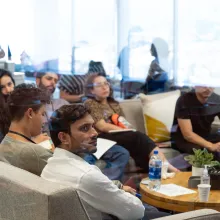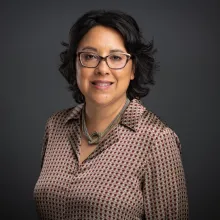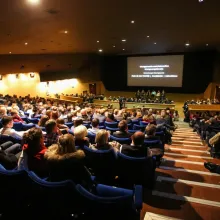In the fall of 2022, IDA launched our inaugural Getting Real Fellowship program, which sought to connect emerging and mid-career documentary professionals who displayed generosity, creative thinking, a desire to build community, and passion for the field. In addition to gathering the fellows in Los Angeles for Getting Real ’22, the fellows co-designed ten workshops, panels, and discussions inspired by their time at the conference. Some of the events were open to the public, while others were designed for fellows only. They covered everything from mental health and sustainability in the
Latest Posts
“Everything old is new again” was the phrase that kept coming to mind during this year’s 32nd edition of the Hot Springs Documentary Film Festival (October 6–14). The first time I attended the Arkansas festival was for the 22nd edition, a much smaller affair. Southern hospitality and charm, it seems, cannot be outgrown in Hot Springs. That sentiment applied to the inaugural two-day Filmmaker Forum, a refreshingly laidback series of panels and one-on-one meetings that took place at the Arlington Hotel, a nearly 150-year-old structure that has long hosted the “longest-running all-documentary
Dear Readers, This past month, as violence flares up around the world and we receive more news about ongoing censorship of documentary filmmakers, we are bolstered by the organizing of our colleagues. Efforts supported by the work of informal and formal collectives include the open letter from UK Documentary Film Council rallying the independent sector, the launch of the DISCO network’s Independence Project , upcoming screenings around the world in solidarity with the film festival Palestine Cinema Days —the 10th anniversary was scheduled to start yesterday—and many more. From our vantage
In August 2021, in my work as Director of Film Impact and Innovation at Peace is Loud, I had a conversation with Fork Films’ former Chief Creative Officer Kat Vecchio about their upcoming grantees. All of the films sounded compelling, but she highlighted one in particular, Fire Through Dry Grass, which embraced a participatory model between seasoned documentarian Alexis Neophytides and one of its protagonists, self-taught filmmaker Andres “Jay” Molina. Alexis and Jay co-directed and collaborated with the film’s participants across all phases of production. At the time, I suggested to Kat that
Editor’s Note: On October 9, the first day of Hot Springs Documentary Film Festival’s two-day Filmmaker Forum, Darcy McKinnon delivered the following keynote address advocating for the value of documentary films as a public good. As a producer, McKinnon has shepherded some of the most vibrant and iconic nonfiction work from the Gulf South in recent years. For nearly a decade, she was the Executive Director of the New Orleans Video Access Center (NOVAC), a nonprofit supporting community-based media in Southeast Louisiana, overseeing a bevy of youth, film industry workforce training, video
The films of New Orleans-based filmmaker Nailah Jefferson share similar grievances despite a variety of subject matter. Some of them try to remain in and protect a sense of place and abundance, as in Vanishing Pearls: The Oystermen of Pointe a la Hache (2014). There are also stories of imagined worlds, escapism, and faraway places, such as Donyale Luna: Supermodel (2023), which was recently released on streaming service Max. And then, others unearth and rebuild a promised land and legacy that’s been burned and buried, such as Descended from the Promised Land: The Legacy of Black Wall Street
In August, ITVS welcomed new CEO and President Carrie Lozano to lead the San Francisco-based nonprofit that has, for over 30 years, funded and partnered with a diverse range of documentary filmmakers to produce and distribute stories that would otherwise be untold. Before ITVS, Lozano built her credentials with varied roles stewarding programs that provide funding, creative labs, fellowships, and artist support. Most recently, she served as the director of Sundance Institute’s Documentary Film and Artist Programs, previously as the director of IDA’s Enterprise Fund, and as an executive at Al
In the crowded landscape of UK documentary production, Grain Media is managing to steer a very difficult path. The company is completely independent and committed to making cinematic films about the issues of our day, films which they unabashedly hope will have an impact and improve the world. In a series of conversations with Documentary, von Einsiedel and his team candidly discussed the ways they work in a climate where budgets are getting much tighter and commissioners are increasingly risk-averse.
Documentary is happy to debut an exclusive clip from Sonia Kennebeck’s latest documentary Reality Winner , which will open at Laemmle Royal and NoHo in LA for special preview screenings on Wednesday, October 18, followed by a weeklong run at Laemmle Glendale. Grasshopper Film will release the film on streaming VOD starting October 31. Reality Winner , on the prosecution of former NSA translator Reality Winner for leaking a Russian election hacking document to the Intercept , is an investigative film five years in the making. Following a SXSW world premiere and subsequent festival run in 2021
Documentary is happy to debut an exclusive clip from David P. Zucker’s documentary Your Friend, Memphis , which will be available to stream on Amazon and Apple TV tomorrow, October 6. This longitudinal documentary takes a vérité approach to recording the life of a young man with cerebral palsy, whose big dreams are not matched by his family’s expectations. On the film, Zucker says, “ Your Friend, Memphis is a coming of age odyssey, following Memphis—an aspiring filmmaker with cerebral palsy—over the course of five years as he pursues a crush on his best friend and strives to build an









